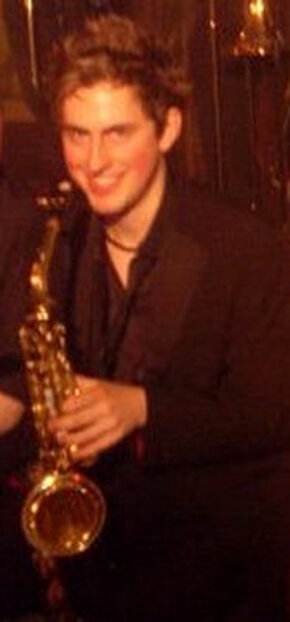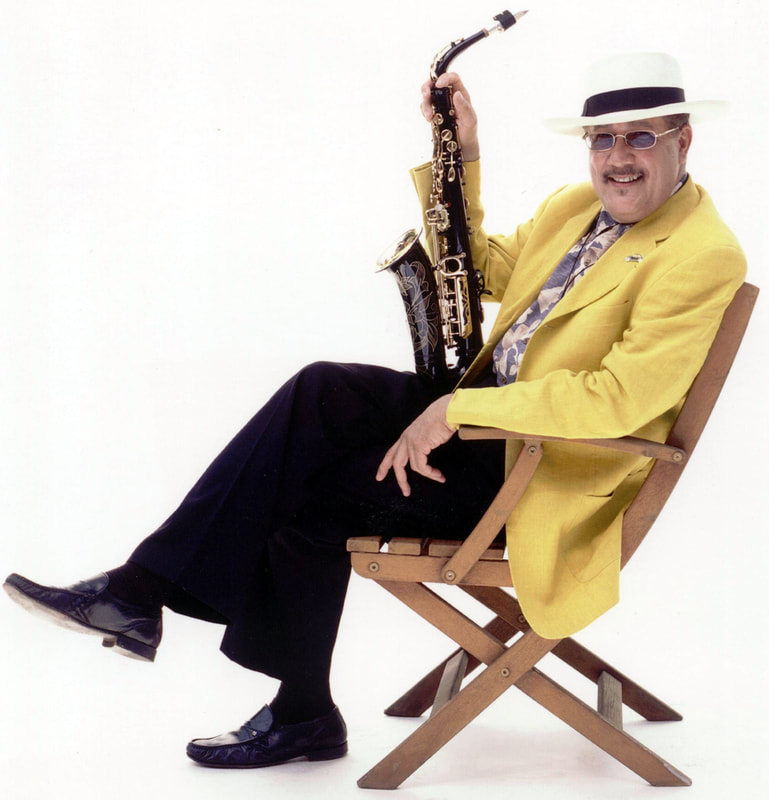Latin Themes |
| Paquito D’Rivera Vals Venezolano & Contradanza Accompanied by Ben Powell (Piano) Paquito D’Rivera is recognized as one of the most well known crossover artists in the music field today. Paquito D’Rivera began his career as a child prodigy, playing alto saxophone and clarinet with the Cuban National Symphony Orchestra. He then went on to become one of the founding members of the Orquesta Cubana de la Musica Moderna, and later, the Latin jazz-fusion group Irakere, |
Vals Venezolano & Contradanza are two Latin dance pieces taken from the suite Aires Tropicales for woodwind quintet, and arranged for saxophone and piano. Aires Tropicales is a seven-movement suite that includes a Habanera as a tribute to Ravel. Therefore, it was the natural choice to segue from the Ravel piece into the Paquito D’Rivera piece. In a similar fashion, Vals Venezolano honours Venezuelan composer Antonio Lauro in a lively syncopated waltz, while Contradanza is Paquito’s upbeat tribute to Cuban composer Ernesto Lecuona.
Astor Piazzolla
Histoire du Tango
Accompanied by Ben Powell (piano), Geoff Chalmers (contrabass) and the Tortoise Island String Quartet
Astor Piazzolla was born of Italian parentage in Argentina, although he was brought up in New York, where he had a strong exposure to jazz. After studying with Nadia Boulanger in Paris, he began to experiment with jazz phrasing and syncopated rhythms in the tango, which up until then, had been ‘four-square’. Combined with his own inquisitive style, the tango swung with new life – subsequently giving birth to the term Tango Nuevo, which caused a tremendous stir in Buenos Aires, and gave Astor Piazzolla an international reputation. Originally for flute and guitar, this four-movement work takes us on a journey tracing the development of the Tango Nuevo throughout the twentieth century, from its humble beginnings to its current worldwide status.
1) Bordel 1900
Bordel 1900 illustrates the initial stage of the tango soon after its genesis in 1882, Buenos Aires. Originally a form of dance music played on guitar and flute, arrangements later included piano and concertina. This movement is full of grace and liveliness. It conveys the playful banter of the French, Italian and Spanish women who populated the bars and bordellos, and teased the policemen, thieves, sailors and everyday folk who frequented them.
2) Café 1930
Café 1930 marks another age of the tango in which people stopped dancing to it and instead preferred simply to listen to it. The tango orchestras expanded to include two violins, two concertinas, piano, bass, and sometimes a singer. Subsequently, the music became more melodic and romantic. It became slower, with sophisticated and often melancholy harmonies.
3) Nightclub 1960
Nightclub 1960 represents a time of rapidly expanding international exchange, and the tango evolved again as the music of Brazil and Argentina came together in Buenos Aires. Bossa Nova and Nuevo Tango moved to the same beat. Audiences flocked to the nightclubs to listen to the new tango, and the nightclub marks a revolution and a fundamental change in the original tango structure.
4) Concert d'Aujourd'hui
Concert d’Aujourd’hui (‘Concert of Today’ or ‘The Modern-Day Concert’) recognizes the fact that the tango has taken on influences from contemporary composers such as Bartok and Stravinsky. This is the point at which the boundaries between ‘popular music’ and ‘art music’ have become blurred. This is today’s tango, and the tango of the future as well.
Accompanied by Ben Powell (piano), Geoff Chalmers (contrabass) and the Tortoise Island String Quartet:
Violin - Elise Harper
Violin - Christina Knox
Viola - Nicola Hicks
Violoncello - Sophia Linehan
Part 2
Concierto de Aranjuez & Spain
Accompanied by Chris Roe (piano), Will McGee (bass),
Dave Simpson, Jon Ormston, Natasa Hadjiandreou (percussion)
Chick Corea is an American jazz piano player, drummer, composer and arranger, most famous for his contribution to the jazz-fusion movement during the 1970s. He was first introduced to Latin music in his youth, and is quoted as saying;
‘I liked the ‘extraversion’ of Latin music, especially the dance and salsa style music – bands like Tito Puente’s band and Machito’s band... The Cuban dance music was a great kind of antidote to some of the more serious, heady jazz that I was into. I liked the ‘outgoingness’ and exuberance of the music. I just stayed interested in all kinds of Latin music. Then I discovered Spanish Latin music, which is flamenco.’
During his early career, Chick Corea worked with many notable Latin Jazz artists – Dizzy Gillespie, Herbie Mann, Willie Bobo, Mongo Santamaría and Stan Getz – and we can see how these experiences might have influenced his music later on. His jazz-fusion group Return to Forever, which began during the early 1970s, included Latin Jazz artists Flora Purim, Airto Moreira and Al Di Meola.
Spain is Chick Corea’s most famous composition. It first appeared on his album Light as a Feather (1971). Chick Corea opened this version with the adagio from Joaquin Rodrigo’s Concierto de Aranjuez – and since then, the song has traditionally been associated with this adagio as a prelude to the main theme.
The salsa song, Sueño como una Gitarra by Adalberto Alvarez, makes reference to this fusion, and heavily inspired my arrangement.
Mark Levine / Cal Tjader
Linda Chicana
Accompanied by Chris Roe (piano), Will McGee (bass), Dave Simpson, Jon Ormston, Natasa Hadjiandreou (percussion)
The cha-cha-chá is a genre of Cuban dance music that evolved from the mambo. Cuban bass player Israel “Cachao” Lopez revolutionised the danzón by adding syncopated bass-lines to the danzón Chanchullo, later recorded by Tito Puente under the title Oye Como Va.
Unlike Cubans, Americans found it difficult to dance to these syncopated rhythms so Enrique Jorrín changed the accent of the mambo so that the strong accent fell on the first beat of the bar. Ironically, the name ‘cha-cha-chá’ was used by Enrique Jorrín to describe the tapping sound made by the shoes of the dancers on the floor as they tried to follow this new rhythm.
Mark Levine, piano player with Mongo Santamaria, wrote Linda Chicana. It has been recorded by many big names in Latin Jazz including Tito Puente, Cal Tjader and Pete Escovado. My arrangement of Linda Chicana is based on the recording by Cal Tjader.
Carlos Santana / Tom Coster
Europa
Accompanied by Chris Roe (piano), Will McGee (bass), Dave Simpson, Jon Ormston, Natasa Hadjiandreou (percussion) and the Barbierian Brass Band
The genesis of this song came from the late 1960s when Carlos Santana suffered a bad experience whilst high on mescaline. Santana composed a song entitled ‘The Mushroom Lady’s Coming to Town’ which contained the original idea for Europa.
Years later, Santana played this song again when he was touring the UK with Earth, Wind and Fire. Tom Coster collaborated with him on the chord sequence, and it was renamed Europa (Earth’s Cry, Heaven’s Smile).
The song was later recorded by the Argentine tenor saxophonist Gato Barbieri, for his album Caliente.
Rory Duffy
Mesozoica
Accompanied by Chris Roe (piano), Will McGee (bass), Dave Simpson, Jon Ormston, Natasa Hadjiandreou (percussion) and the Barbierian Brass Band
This piece was adapted from Paleaontology, a big band work I that wrote in 2006, and it is inspired by the 6/8 and 12/8 cross-rhythms from traditional West African sacred music. The composition is a journey through both spatial and temporal dimensions. I intended to transport the listener through a formal landscape where the dynamic contour of the music traces the natural topography of the landscape – forests, rivers, mountains and valleys.
The listener is at first lost in a dense forest. He finds running water, and follows the current upstream to the slope of a mountain. He climbs the mountain and, upon his arrival at the summit, looks down into the valley below and sees something so wonderful, it is beyond comprehension. He descends the mountain towards the object of wonder, but just before he reaches it, he looks to the side and catches a glimpse of new, unexplored territory.
The composition is effectively an exploration into the concepts of time and space in both an anthropomorphic and geological sense. The 6/8 and 12/8 cross-rhythms are always present in the music, yet they only manifest themselves in the bell that rings during the moment of transcendence – when the listener witnesses that vision so marvellous that he is momentarily lost in contemplation.
I wanted to draw the parallel between the Latin rhythms that originate from the motherland Africa (a process that took over a century) as a temporal microcosm for the evolution of life from the dawn of the Mesozoic age to today. Time suddenly loses all meaning, and the progress of time within the composition feels as long as the evolution of history itself.
Similarly, I wanted to create a sense of ecological rationality where man becomes fused with the natural environment. Thus, the listener is thrown into a state of simultaneous anticipation and recollection, ascent and descent, self and world, where the flux of time and space merge into one experience.
The Barbierian Brass Band
Trumpet 1 - Nick Walters
Trumpet 2 - Jack Davies
Flute - Emily Ogilvie
Alto Saxophone - Anthony Brown
Baritone Saxophone - Rob Cope
Trombone 1 - Simon Lodge
Trombone 2 - Patrick Friel
Events
For up-to-the minute information on Rory's availability, check out the live event calendar, updated via iCal and published live to the calendar page of this website.
Archives
August 2024
July 2024
June 2024
May 2024
April 2024
March 2024
February 2024
January 2024
December 2023
November 2023
September 2023
August 2023
July 2023
June 2023
April 2023
December 2022
November 2022
October 2022
September 2022
August 2022
July 2022
June 2022
May 2022
April 2022
March 2022
February 2022
December 2021
October 2021
September 2021
August 2021
July 2021
June 2021
April 2021
December 2020
November 2020
October 2020
September 2020
August 2020
July 2020
March 2020
February 2020
January 2020
December 2019
October 2019
September 2019
August 2019
July 2019
June 2019
May 2019
April 2019
March 2019
February 2019
December 2018
November 2018
September 2018
August 2018
July 2018
June 2018
May 2018
April 2018
February 2018
December 2017
November 2017
October 2017
September 2017
August 2017
July 2017
June 2017
May 2017
April 2017
March 2017
February 2017
December 2016
November 2016
October 2016
September 2016
August 2016
July 2016
June 2016
May 2016
April 2016
March 2016
January 2016
November 2015
October 2015
September 2015
August 2015
July 2015
June 2015
May 2015
March 2015
February 2015
December 2014
November 2014
October 2014
September 2014
August 2014
July 2014
June 2014
May 2014
March 2014
February 2014
January 2014
November 2013
October 2013
September 2013
August 2013
July 2013
June 2013
May 2013
April 2013
March 2013
February 2013
January 2013
December 2012
November 2012
October 2012
September 2012
August 2012
July 2012
June 2012
May 2012
March 2012
January 2012
November 2011
October 2011
August 2011
July 2011
June 2011
May 2011
April 2011
March 2011
February 2011
December 2010
November 2010
October 2010
September 2010
August 2010
July 2010
June 2010
May 2010
April 2010
March 2010
February 2010
January 2010
December 2009
November 2009
October 2009
September 2009
June 2009
April 2009
March 2009
May 2008
March 2008
December 2007
June 2007
May 2007
March 2007



 RSS Feed
RSS Feed